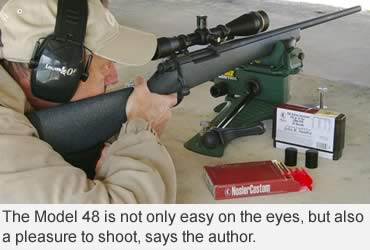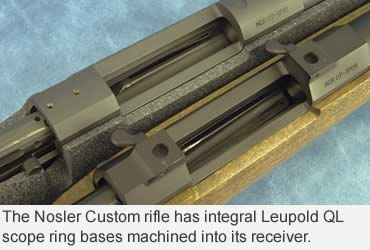By Jon R. Sundra
This step down from the Custom Limited Edition is a semi-production gun offered in 10 chamberings.
Mention the name Nosler to any hunter in the world, and it immediately elicits a mental image of bullets, particularly the Nosler Partition on which the company was founded and built its reputation. It all started in 1948 in a small building behind John Nosler’s home. Employee parking was not a problem back then, for it was only John, his wife, Louise, and a family friend who would occasionally help out.
I can remember early on in my handloading career that Nosler Partition bullets had annular machining marks like they had been turned on a lathe or screw machine.
That’s because they were!
The company’s certainly come a long way since then. Next to the Partition bullet, Nosler is perhaps best known for pioneering the Ballistic Tip, a bullet with a polycarbonate tip — a feature that has since been copied by virtually every major component bullet manufacturer in the U.S.
What a lot of people don’t know, however, is that Nosler is now heavily involved in the bolt-action rifle and ammunition business. In 2005, the company launched three symbiotic divisions: Nosler Custom Rifles, Nosler Custom Brass and Nosler Custom Ammunition.
 Two models are in the custom rifle line. The Nosler Custom is a limited-edition rifle that is offered each year in one caliber. The first edition of 500 guns, announced in 2006, was chambered in .300 WSM. The second edition, interestingly enough, is in .280 Ackley Improved, now a quasi-wildcat because Nosler Custom Ammunition is offering both brass and loaded ammunition in the caliber.
Two models are in the custom rifle line. The Nosler Custom is a limited-edition rifle that is offered each year in one caliber. The first edition of 500 guns, announced in 2006, was chambered in .300 WSM. The second edition, interestingly enough, is in .280 Ackley Improved, now a quasi-wildcat because Nosler Custom Ammunition is offering both brass and loaded ammunition in the caliber.
To complement the Custom Limited Edition rifle, Nosler announced last year the Model 48, a less-expensive, semi-production rifle that is now being offered in 10 chamberings: .22-250 Rem, .260 Rem., 6.5-284 Norma, .270 WSM, 7mm-08 Rem, .280 Ackley Imp., .300 WSM, .308 Win., .325 WSM and .338 Federal. The “48” designation signifies the year that John Nosler started his bullet business.
The Nosler folks sent us the very first production example of the Model 48 chambered in .280 Ackley Improved. Also provided for testing were two of the three factory loads being offered: a 140-grain AccuBond from the Trophy line, and a 150-grain E-Tip from the Custom line. The Custom line is the most comprehensive of the two, with cartridges virtually handloaded using select components, and then hand-packaged in boxes that can be custom-labeled for the purchaser. The Trophy line is more of a production grade, but one of very high standards. The Custom Limited Edition rifle is guaranteed to shoot 1/2-inch groups using Nosler Custom ammunition, while the Model 48 is guaranteed to shoot 3/4 inch.
The action around which both the Custom and the Model 48 are built is very similar to the Howa 1500. As such, it’s a hybrid, just like the Dakota 76 and the Montana Model 1999 actions are basically pre-’64 Winchester Model 70s. I hasten to add, however, this action is not a Howa. There are substantial differences in details like the machining of the receiver top surfaces and recoil lug, as well as in the bottom metal unit, trigger, bolt body and shroud, bolt stop/release, and, of course, the stocks. In other words, just about everything about these Nosler rifles is different from the Howa, yet in a side-by-side comparison, the similarities in the basic bolts and receivers are striking.
 We’re going to concentrate on the Model 48, which costs $1,400 less than the Custom Limited Edition. Only 500 of the latter guns are made, and in only one caliber. Aside from that, the most significant differences between the two guns is in the stock, and the fact that the CLE version has integral Leupold QL bases machined into the receiver. Those of you familiar with this particular scope mount know how much machining is required to make these bases integral. It’s really a neat feature. Also with the CLE, you get two boxes of Custom ammo specifically loaded for that individual rifle, and a Kalispell aluminum travel case.
We’re going to concentrate on the Model 48, which costs $1,400 less than the Custom Limited Edition. Only 500 of the latter guns are made, and in only one caliber. Aside from that, the most significant differences between the two guns is in the stock, and the fact that the CLE version has integral Leupold QL bases machined into the receiver. Those of you familiar with this particular scope mount know how much machining is required to make these bases integral. It’s really a neat feature. Also with the CLE, you get two boxes of Custom ammo specifically loaded for that individual rifle, and a Kalispell aluminum travel case.
As already noted, the 48’s barreled action is essentially the same as the CLEs, except that the receiver has a round top. The ring/ bridge contours are the same as the Remington 700’s, as well as the spacing of the tapped holes, so any mount base that fits a Model 700 will work for the Nosler Model 48. The barreled action is protected with a highly durable Cerakote finish. The action is glass-bedded, and the barrel is fully floated the entire length of the fore-end.
To ready the Model 48 for testing, we mounted a new Leupold FX3 25x40 scope using Weaver rings and bases. It’s not your typical hunting scope, but one that largely takes shooter error out of the picture. The scope is remarkably light and compact considering its impressive magnification. Ready to go, the rig weighed 8 pounds, 10 ounces, thanks to a medium sporter-weight barrel.
 The trigger, designed and made by Timney, is excellent, as is its integral, three-position side safety. The middle position allows the bolt to be worked so the gun can be loaded and unloaded with the safety engaged. The bolt glide is very tight and smooth, thanks in part to the bolt’s fluting. The flutes are very shallow, but unless you’re also trying to reduce weight, all it takes is a depth of a few thousandths to reduce friction and smooth bolt travel. The bolt and receiver are coated with MicroSlick, which also helps.
The trigger, designed and made by Timney, is excellent, as is its integral, three-position side safety. The middle position allows the bolt to be worked so the gun can be loaded and unloaded with the safety engaged. The bolt glide is very tight and smooth, thanks in part to the bolt’s fluting. The flutes are very shallow, but unless you’re also trying to reduce weight, all it takes is a depth of a few thousandths to reduce friction and smooth bolt travel. The bolt and receiver are coated with MicroSlick, which also helps.
There were no cartridge-feeding or extraction failures during bench testing, and the overall functioning of the rifle was excellent, as was the very crisp 3-pound trigger. Accuracy was quite good, with the very first three-shot group punching a perfect clover leaf measuring a scant .480 inch! That Nosler Custom 150-grain E-Tip load turned out to be the most accurate, but the average for five three-shot groups was .87 inch, and the conditions were far from ideal. There were gusting crosswinds of 10-12 mph, and a bright sun, making mirage a problem. With the Trophy Grade 140-grain AccuBond load, we managed an average of 1.1 inch for five three-shot groups, discounting two fliers that I’m sure were not me. Based on the conditions prevailing at the time, I’d have to say yes, this particular gun would qualify as a 3/4-MOA rifle. It’s also quite an elegant one, if you can use that term describing a synthetic-stocked rifle. Some conservatives would say not, but I’m not one of them. This is an excellent, highly refined rifle that goes a long way in justifying its $2,595 price tag.
This article was published in the August 2009 edition of Buckmasters GunHunter Magazine. Subscribe today to have GunHunter delivered to your home.